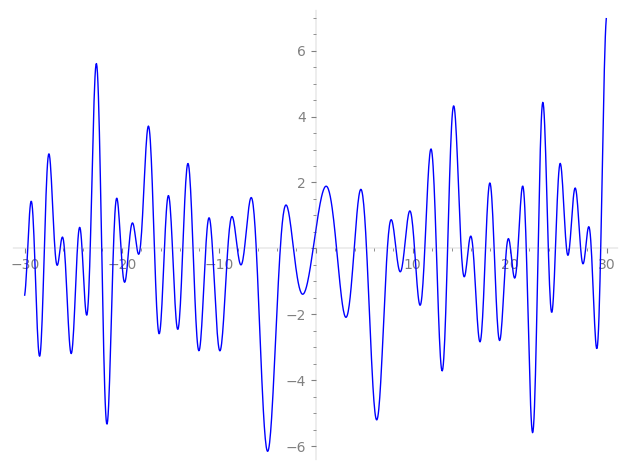| L(s) = 1 | − 2.82·2-s + (6.09 − 6.62i)3-s + 8.00·4-s + (−17.8 + 17.8i)5-s + (−17.2 + 18.7i)6-s + (8.63 − 8.63i)7-s − 22.6·8-s + (−6.82 − 80.7i)9-s + (50.4 − 50.4i)10-s + (−112. − 112. i)11-s + (48.7 − 53.0i)12-s + 45.0·13-s + (−24.4 + 24.4i)14-s + (9.56 + 226. i)15-s + 64.0·16-s + (−285. + 42.0i)17-s + ⋯ |
| L(s) = 1 | − 0.707·2-s + (0.676 − 0.736i)3-s + 0.500·4-s + (−0.713 + 0.713i)5-s + (−0.478 + 0.520i)6-s + (0.176 − 0.176i)7-s − 0.353·8-s + (−0.0842 − 0.996i)9-s + (0.504 − 0.504i)10-s + (−0.932 − 0.932i)11-s + (0.338 − 0.368i)12-s + 0.266·13-s + (−0.124 + 0.124i)14-s + (0.0425 + 1.00i)15-s + 0.250·16-s + (−0.989 + 0.145i)17-s + ⋯ |
\[\begin{aligned}\Lambda(s)=\mathstrut & 102 ^{s/2} \, \Gamma_{\C}(s) \, L(s)\cr =\mathstrut & (-0.952 + 0.305i)\, \overline{\Lambda}(5-s) \end{aligned}\]
\[\begin{aligned}\Lambda(s)=\mathstrut & 102 ^{s/2} \, \Gamma_{\C}(s+2) \, L(s)\cr =\mathstrut & (-0.952 + 0.305i)\, \overline{\Lambda}(1-s) \end{aligned}\]
Particular Values
| \(L(\frac{5}{2})\) |
\(\approx\) |
\(0.0830031 - 0.529951i\) |
| \(L(\frac12)\) |
\(\approx\) |
\(0.0830031 - 0.529951i\) |
| \(L(3)\) |
|
not available |
| \(L(1)\) |
|
not available |
\(L(s) = \displaystyle \prod_{p} F_p(p^{-s})^{-1} \)
| $p$ | $F_p(T)$ |
|---|
| bad | 2 | \( 1 + 2.82T \) |
| 3 | \( 1 + (-6.09 + 6.62i)T \) |
| 17 | \( 1 + (285. - 42.0i)T \) |
| good | 5 | \( 1 + (17.8 - 17.8i)T - 625iT^{2} \) |
| 7 | \( 1 + (-8.63 + 8.63i)T - 2.40e3iT^{2} \) |
| 11 | \( 1 + (112. + 112. i)T + 1.46e4iT^{2} \) |
| 13 | \( 1 - 45.0T + 2.85e4T^{2} \) |
| 19 | \( 1 - 14.5iT - 1.30e5T^{2} \) |
| 23 | \( 1 + (550. + 550. i)T + 2.79e5iT^{2} \) |
| 29 | \( 1 + (494. - 494. i)T - 7.07e5iT^{2} \) |
| 31 | \( 1 + (1.06e3 + 1.06e3i)T + 9.23e5iT^{2} \) |
| 37 | \( 1 + (719. + 719. i)T + 1.87e6iT^{2} \) |
| 41 | \( 1 + (-1.54e3 - 1.54e3i)T + 2.82e6iT^{2} \) |
| 43 | \( 1 + 882. iT - 3.41e6T^{2} \) |
| 47 | \( 1 + 742. iT - 4.87e6T^{2} \) |
| 53 | \( 1 - 4.49e3T + 7.89e6T^{2} \) |
| 59 | \( 1 + 3.49e3T + 1.21e7T^{2} \) |
| 61 | \( 1 + (-1.35e3 + 1.35e3i)T - 1.38e7iT^{2} \) |
| 67 | \( 1 - 161.T + 2.01e7T^{2} \) |
| 71 | \( 1 + (-6.21e3 + 6.21e3i)T - 2.54e7iT^{2} \) |
| 73 | \( 1 + (680. + 680. i)T + 2.83e7iT^{2} \) |
| 79 | \( 1 + (-2.57e3 + 2.57e3i)T - 3.89e7iT^{2} \) |
| 83 | \( 1 - 6.64e3T + 4.74e7T^{2} \) |
| 89 | \( 1 - 809. iT - 6.27e7T^{2} \) |
| 97 | \( 1 + (75.7 + 75.7i)T + 8.85e7iT^{2} \) |
| show more | |
| show less | |
\(L(s) = \displaystyle\prod_p \ \prod_{j=1}^{2} (1 - \alpha_{j,p}\, p^{-s})^{-1}\)
Imaginary part of the first few zeros on the critical line
−12.64679570951961287711058865518, −11.33676280341285890086816481020, −10.64533687464388034397354280005, −9.062233822365865629592074941653, −8.081042586214801048052361551262, −7.34463598213376956795746284215, −6.13067386240474646075447577541, −3.65319271766176849238110228164, −2.29305162239886807372755822628, −0.26388525792944156211798917339,
2.14994526652032046963297903790, 3.96598775065690446702748785176, 5.23713677025052805020286507401, 7.38569938035671063657781516927, 8.267608470229215195272966368523, 9.146085426228163180014691167430, 10.18463727383309222294479891253, 11.24487915080018495624434572116, 12.43387106831122373663118279043, 13.59365545125943453693553323666

